Keywords
|
| Mobile Ad-hoc Network; Reactive routing protocol; Hello message; RREQ; Energy constraint. |
INTRODUCTION
|
| Mobile Ad-hoc Network (MANET) [7] is a self-configuring infrastructure-less network consisting of mobile hosts. Each node in MANET can move in any direction and thereby change its links to other devices frequently. Nodes in MANET can send a message to other nodes without the support of any centralized infrastructure. The mobile nodes can directly communicate to nodes that are in its radio range, whereas to communicate with other nodes it needs the help of the routing protocol to relay the packets efficiently through intermediate nodes [3]. MANET relies on routing protocol for path establishment and maintenance. Based on route discovery process the routing protocol in MANET is categorized into three main divisions namely, proactive, reactive and hybrid protocols [2]. Routing protocols in MANET must deal with different challenges [8] such as, dynamic topology, limited resources, low bandwidth, and high error rates to provide efficient and secure delivery of packets. |
| Reactive protocols do not maintain the routing information when there is no data transfer. If a node wants to communicate with another node then the protocol searches for the route in an on-demand manner to establish a path for data transfer. The route establishment usually occurs by flooding the RREQ (Route Request) packet and local link connectivity through broadcasting Hello message throughout the network. One such reactive routing protocol is AODV. AODV [1] is an on-demand routing protocol. AODV broadcast Hello packet to obtain the local connectivity information for every HELLO_INTERVAL. The route discovery process is initiated by the source through broadcasting the RREQ packet to its neighbours. The intermediate node on receiving the RREQ sends the RREP (Route Reply) packet to the source if it has the path to destination or is the destined destination. Otherwise it rebroadcast the RREQ to its neighbours. This process continues until the destination is reached. The source node after receiving RREP starts the data transmission. If a link break occurs during the data transmission RERR (Route Error) packet is sent to the source by the node detecting the link failure. The source, then reinitiate the route discovery process. The main drawback of the reactive protocol is it finds the shortest route to destination without considering the lifetime of the route and unnecessary/superfluous periodic broadcast of hello messages, waste nodes energy. The main objective of this paper is to reduce the unnecessary control overhead due to hello packets, to find the route containing nodes with good lifetime and to increase the lifetime of the nodes in the network which solves the network partition problem. |
RELATED WORK
|
| Periodic hello messaging is a widely-used scheme to obtain local link connectivity information. However unnecessary hello messages can drain the battery power of the node wastefully when they are not in use. An adaptive hello messaging scheme (AODV-AH) was developed in [6] that dynamically adjusts hello interval of a node. The status of the link need not be maintained by the node that is not active in the network. The active participation of the node is determined by monitoring the event intervals. To estimate the risk of sending the packet through the broken link, an average event interval is calculated and hello interval is dynamically updated. CDF of the exponential distribution is used to calculate the hello interval dynamically. |
| In ELBRP [4] forwarding decisions are made based on the node’s energy level. In ELBRP, the energy level of the node were normalized and classified into 4 distinct states: very danger, danger, sub safety and safety with [0, γ], [γ, β], [β, α], [α, 1] as their respective energy level. During sub-safety state ELBRP follows the request-delay mechanism. In request-delay mechanism, the intermediate nodes upon receiving an RREQ, holds it for a time inversely propositional to the energy level of the node. After the expiration of the holding time, node forwards the RREQ to its neighbours. During the holding time of the node with lower energy, the RREQ could have reached the neighbour node through other stronger path. So, the RREQ packet forwarded by the lower energy intermediate node will be a duplicate packet and will be discarded. This procedure is repeated until RREQ reaches the destination. Thus, the stronger path is found. During the very danger state, the node is entered into the sleep state. The nodes in sleep are wakened at the time when they are the destination or when they are the only neighbour of the destination. |
| PSR [5] was developed to solve the network partition problem. Dead state causes some nodes to become unreachable from other active nodes in the network. During route discovery, all nodes except the destination calculate the cost for finding a route during route discovery time t. The calculated cost value is then appended to the RREQ header before being forwarded. Intermediate nodes on receiving the RREQ, assumes received cost in RREQ header as the MinCost. As the duplicate RREQs arrive; the RREQ packet's cost is compared to the Min-Cost. If the RREQ has a cost lower than Min-Cost, Min-Cost's value is updated to this new value. Otherwise, it is dropped. When the first RREQ reaches the destination, it starts the timer Tr. During which the destination scrutinize the cost of the route of every duplicate RREQ. When the Tr expires, the destination node selects the path with the minimum cost and sends RREP. The RREP as well contains the cost of the selected path appended to it. Each node on the selected path as receives the RREP adds an entry to the route cache table. Route cache table is updated with the route along with its cost. In PSR, link failure is caused due to both the mobility and energy depletion of the node. During the first case, an RERR is sent to the source then the source initiates a new route discovery process. Semi-global Approach and Local Approach can be used to resolve second case. PSR uses local approach since they minimizes control traffic. In Local approach, each intermediate node in the path starts to track its energy level as soon as the path is discovered. When the link cost exceeds the energy level, the route error message is sent to the source. |
PROPOSED METHODOLOGY
|
| Improved Suppressing of Superfluous Hello Messages |
| Each node periodically broadcast hello message to its single hop neighbours for each constant HELLO_INTERVAL to obtain the local-link connectivity information. When mobile nodes are not in use this periodic hello message becomes surplus and unnecessary. Unnecessary hello messages drains node’s energy wastefully, which could have been used for other useful work. Using the proposed method, unnecessary "Hello" is suppressed effectively. |
| In the proposed system, to suppress unnecessary hello messages, a dynamically adjustable hello messaging method is used. The proposed scheme dynamically adjusts the Hello interval, without reducing the detectability of broken links. To suppress superfluous “Hello” messages, the HELLO_INTERVAL of a node is dynamically tuned based on the routing activity of the node. To perform this, inter-arrival time of packets to the node is calculated and is monitored continuously. By monitoring the event intervals, activeness of the node in the network is determined. If a |
| node is not involved in any message transfer for a given period, maintaining the link information with its neighbours is not required. So, the Hello packets broadcasted during this period are useless. |
| All traffic in MANET are bounded by the exponential distribution, the CDF (Cumulative distribution Function) of exponential distribution is used to calculate the HELLO_INTERVAL. The probability of not detecting failure link is denoted with PFD. The CDF is rewritten as in equation 3.1. |
 |
| Where, |
| x - Hello interval time, β - Average event interval of a node, PFD - Probability of frequency distribution (constant value) |
| x increases linearly as β increases. |
| Equation 2.1 is used to calculate the new hello interval time at which the subsequent hello packets need to be sent. As the event interval increases, the Hello interval x is also increased. In [], the PFD value is kept constant and it takes the value between 0.0 < PFD < 1.0. A high constant PFD value results in longer hello interval than low PFD. In some case, a high PFD value increase the risk of sending the packet through broken link and low PFD causes numerous Hello packets to be sent. Hence in our proposed method the PFD value is also adjusted gradually based on the routing. To perform this node monitors the network, when it senses a link breakage it keeps a count on them. Based on the RERR count value PFD is updated dynamically |
| Finding the Path with Good Energy Level Nodes |
| Most of the reactive routing protocols in MANET considers shortest path as the routing metric to select the route. When a source node needs to find a route to destination it broadcast RREQ. Each intermediate node on receiving the RREQ continues to propagate the RREQ until the destination is found. Due to the shortest path metric of the routing protocol, path containing nodes with good energy level is ignored and the path with minimum hop count is selected which may contain the low energy level nodes. Thus continues forwarding of packets for other nodes lessens the node’s energy and make the node to end up in a dead state resulting in network partition. Using the proposed system the strong path containing node with good energy level nodes is selected to balance energy level among nodes in the network. |
| In the proposed system, each node in the network maintains the energy level of the neighbours in addition to the neighbours list using the hello packet it receives from the neighbours. During the path discovery, a node sends/ forwards RREQ to all nodes in the network with good energy level. Thus the node with minimum energy is made unaware of the path finding. Minimum energy node is made to enter the sleep state by its neighbours to conserve its energy. The conserved energy of such node is used for its own routing purpose and when necessary i.e. when they are the only node which has the link to the destination. Thus a node forwards “RREQ” message to the low energy node (LN) only if it finds LN to be the destination or the only intermediate node through which the destination can be reached. |
| Figure 1.a shows the route establishment of existing AODV. The network consists of nine nodes with node E having the minimum energy. The source node S tries to find the route to destination node D by broadcasting RREQ to all nodes in the network without considering the energy level of the node. The source node S broadcast RREQ to all its neighbours including low energy node E. By considering, shortest path as the routing metric, the shortest path S-E-D is selected ignoring the other strong paths. |
| Figure 1.b shows the path discovery process of proposed AODV. With the same topology situation, in the proposed AODV method of rote establishment is different from existing AODV. The source node S tries to find the path to destination node D by sending RREQ to all nodes in the network except to the low energy nodes. By considering, the energy level of neighbour node, the source node S send RREQ to all nodes except low energy node E and the RREQ is forwarded with the same condition. Thus a strong path S-F-C-D with energy level nodes is selected. |
SIMULATION RESULTS
|
| The simulation is carried out using NS-2.27 [9] (Network Simulator). The parameter required to carry out the simulation is listed in table1. |
| a. Improved Suppressing of Superfluous Hello Messages |
| The number of hello message broadcasted by modified AODV, AODV-AH and Existing AODV is compared in Figure 2. From the figure we note a far decrease in hello message count of modified AODV compared to existing AODV. Though the number of hello message broadcasted by AODV-AH is far less than existing AODV, modified AODV sends much less hello packets. |
| The throughput of the network increases with decrease in hello message. Figure 3. shows throughput of the network under AODV-AH, existing and modified AODV. With modified AODV the throughput of the network increases by 7% compared to existing AODV. |
| As the strongest path selection is done with constraint sending of Route Request packet. The routing packets required to send packets in modified AODV is less than the existing AODV. Figure 4. shows the number of routing packets required in Existing and Modified AODV with respect to number of nodes in the network. |
| Due to strong path selection (i.e. path containing node with good lifetime) the route error packet which is sent to notify packet loss is sent less in modified AODV compared to existing one. Figure 5. confirms such reduction in modified AODV when compared with existing AODV. |
CONCLUSION
|
| In MANET, large number of control packets is broadcasted into the network to establish and maintain the path. Such packet sometimes becomes superfluous and become unnecessary. The proposed scheme improved suppressing of superfluous hello messages, suppresses such unwanted hello message based on the activeness of the node in the network. This causes the throughput of the network to increase by 7% in dense network. The proposed scheme also establishes a strong path with good energy level nodes which resolves failure in packet transmission due to dead nodes in the path. It also solves the network partition problem by saving the battery power of the nodes with minimum energy. |
Tables at a glance
|
 |
| Table 1 |
|
| |
Figures at a glance
|
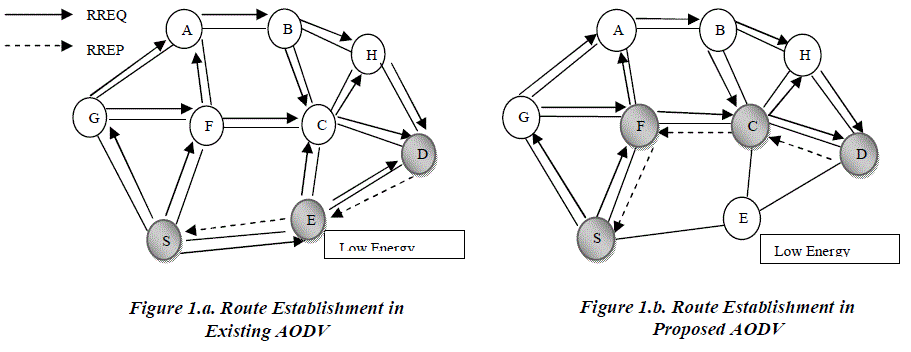 |
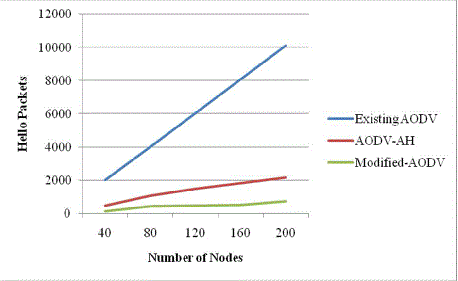 |
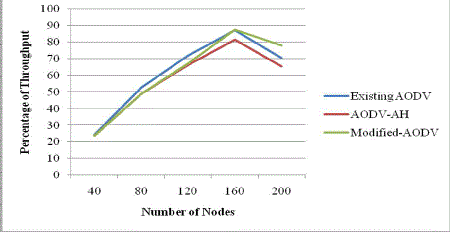 |
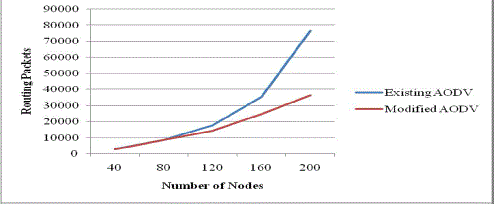 |
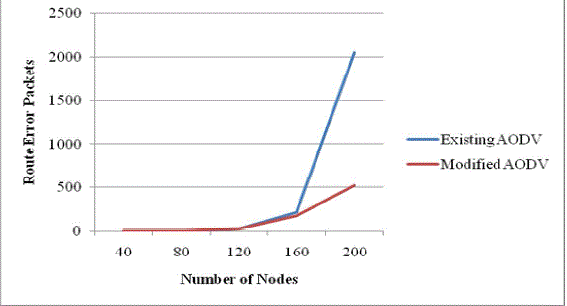 |
| Figure 1 |
Figure 2 |
Figure 3 |
Figure 4 |
Figure 5 |
|
| |
References
|
- Charles Perkins E. and Elizabeth Royer M., “Ad-hoc On-demand Distance Vector Routing”, IEEE Conference on Mobile Computing Systems and Applications, pp. 90 – 100, 1999.
- Elizabeth M. Royer, Chai-KeongToh, “A Review of Current Routing Protocols for Ad Hoc Mobile Wireless Networks”, IEEE Personal Communications, pp. 46-55, 1999.
- Hoebeke J., Moerman I., Dhoedt B. and Demeester P., “An overview of mobile ad hoc networks: Applications and challenges”, Journal of the Communications Network, Vol.3, pp.60-66, 2004.
- Li Layuan, Li Chunlin and Yuan Peiyan, “An Energy Level Based Routing Protocol in Ad-hoc Networks”, IEEE/WIC/ACM International Conference on Intelligent Agent Technology, pp. 306 – 312, 2006.
- MortezaMaleki, KarthikDantu and MassoudPedram, “Power-aware Source Routing Protocol for Mobile Ad-Hoc Networks”, International Symposium on Low Power Electronics and Design, pp. 72 – 75, 2002.
- SeonYeong Han, Dongman Lee, “An Adaptive Hello Messaging Scheme for Neighbor Discovery in On-Demand MANET Routing Protocols”, IEEE Communications Letters, Vol. 17, No. 5, pp. 1040 – 1043, 2013.
- Subir Kumar Sarkar, Basavaraju T.G., Puttamadappa C., “Ad Hoc Mobile Wireless Networks”, Auerbach Publications, 2008.
- Taneja, K & Patel, RB, “Mobile Ad Hoc Networks: Challenges and Future”, Proceedings of National Conference on Challenges & Opportunities in Information Technology, pp.133-135, 2007.
- TerawatIssariyaku and EkramHossain, ‘Introduction to Network Simulator NS2’ Springer Publication, 2009
|